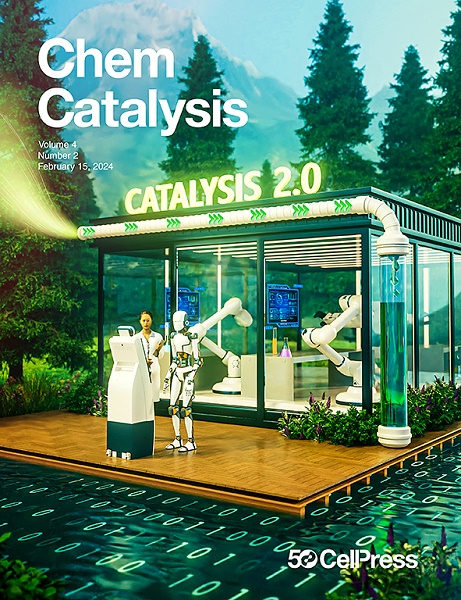差压CO2电解为工业过程的直接耦合开辟了道路
IF 11.6
Q1 CHEMISTRY, PHYSICAL
引用次数: 0
摘要
加压电化学二氧化碳还原(CO2R)提供了一种提高选择性、电流密度和工艺集成的途径。虽然高压可以改善CO2R性能,但阴极和阳极之间的差压操作仍未得到充分开发。本研究介绍了一种创新的测试设备和具有零间隙结构的连续高压反应器,可在40 bar(g)的差压下实现气态CO2电解。使用双极膜电极组件消除了二氧化碳加湿的需要,并且使用超纯水作为唯一的质子源,可以创建无酸或无碱添加剂的无盐环境。该装置在500 mA cm−2下实现了81%的CO法拉第效率,在CO2过量(λCO2)低于4的情况下实现了高效的CO2R,在40 bar(g)下的单次转换率高达26%。加压的CO2R出口流的二氧化碳含量低,可以直接集成到下游的化学过程中。这标志着向可扩展、节能的工业二氧化碳电解系统的关键进步。本文章由计算机程序翻译,如有差异,请以英文原文为准。

Differential pressure CO2 electrolysis opens the way for direct coupling to industrial processes
Pressurized electrochemical carbon dioxide reduction (CO2R) offers a pathway to enhance selectivity, current density, and process integration. While elevated pressures improve CO2R performance, differential pressure operation above 10 bar between cathode and anode remains underexplored. This study introduces an innovative test facility and a continuous high-pressure reactor with a zero-gap architecture, enabling gaseous CO2 electrolysis at a differential pressure of 40 bar(g). Using a bipolar membrane electrode assembly eliminates the need for CO2 humidification, and using ultrapure water as the sole proton source creates a salt-free environment without acid or base additives. This setup achieved a Faraday efficiency for CO of 81% at 500 mA cm−2, efficient CO2R with a CO2 excess (λCO2) below 4, and single-pass conversion rates up to 26% at 40 bar(g). The pressurized CO2R outlet streams have low CO2 content, enabling direct integration into downstream chemical processes. This marks a key advancement toward scalable, energy-efficient industrial CO2 electrolysis systems.
求助全文
通过发布文献求助,成功后即可免费获取论文全文。
去求助
来源期刊
CiteScore
10.50
自引率
6.40%
发文量
0
期刊介绍:
Chem Catalysis is a monthly journal that publishes innovative research on fundamental and applied catalysis, providing a platform for researchers across chemistry, chemical engineering, and related fields. It serves as a premier resource for scientists and engineers in academia and industry, covering heterogeneous, homogeneous, and biocatalysis. Emphasizing transformative methods and technologies, the journal aims to advance understanding, introduce novel catalysts, and connect fundamental insights to real-world applications for societal benefit.

 求助内容:
求助内容: 应助结果提醒方式:
应助结果提醒方式:


